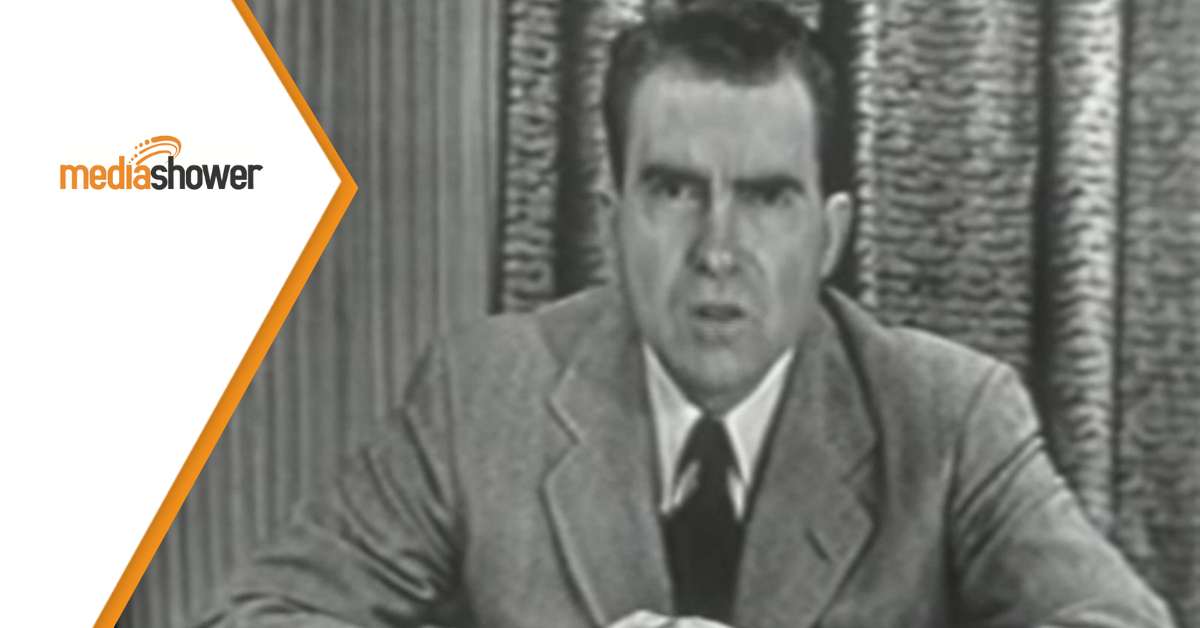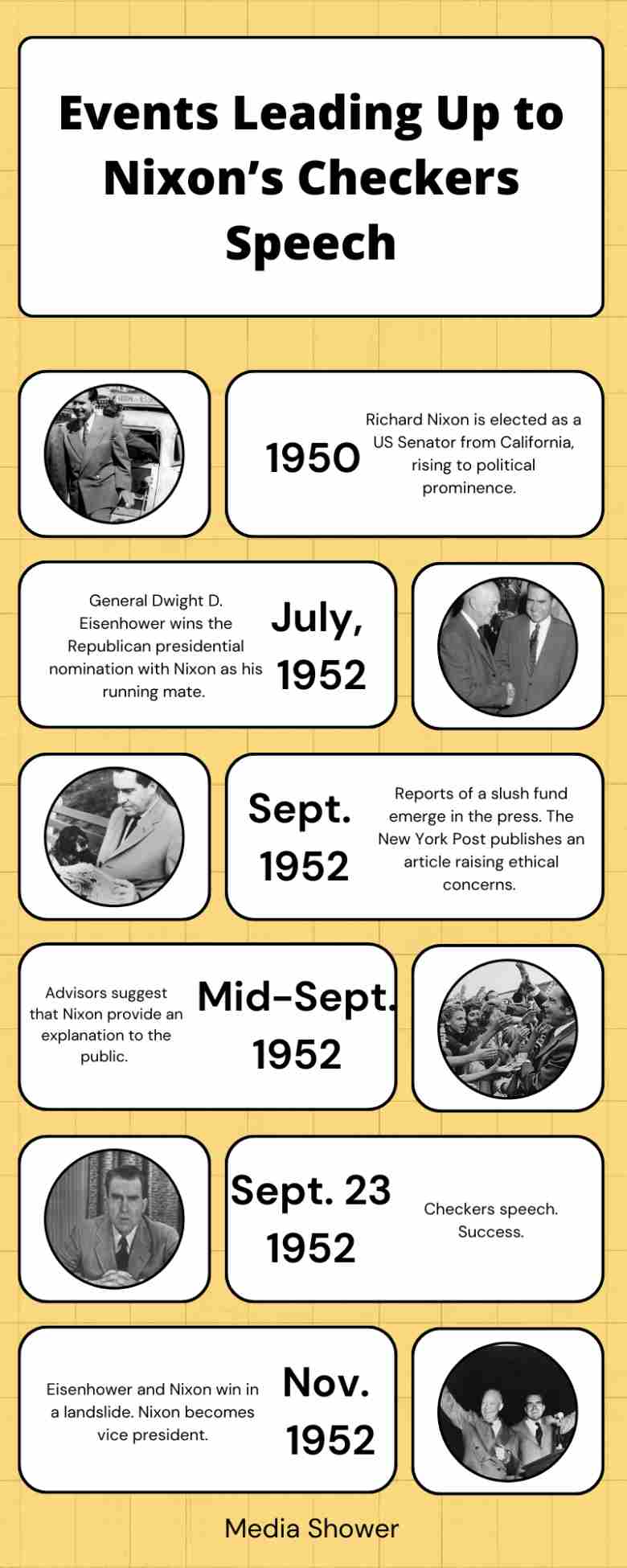
Los Angeles, California. September 23, 1952. 6:30 PM, Pacific Time. Senator Richard Nixon takes a seat in front of the television cameras and stares into the nation’s soul through grainy black and white television screens. In a few moments, he utters the first words of one of the most consequential political speeches in US history.
Richard Nixon’s Checkers speech is a master class in tackling political controversy by appealing to the audience’s emotions. In his iconic address, Nixon opened his life and financial records to the public, building emotional connections through convincing body language and personal stories, including one about the family dog.
In this article, we unpack the the communication techniques behind Nixon’s famous “Checkers” speech, focusing on what modern communicators can learn from his strategy and delivery.
Build Emotional Connections
“And you know, the kids, like all kids, love the dog, and I just want to say this, right now, that regardless of what they say about it, we’re going to keep it.”
Checkers was a black-and-white cocker spaniel Nixon’s family received from a supporter in Texas as a “political gift.” The senator evokes the dog as part of a personal story that gives the public an insight into his family life.
Personal storytelling is an effective messaging technique, the power of which Nixon didn’t hesitate to exploit in his Checkers speech.
The story about Checkers served multiple purposes:
- It humanized the storyteller.
- Evoking the image of a traditional American family, it shifted the focus away from the political accusations at hand.
- It created an emotional connection with the audience.
- Cast as the only “political gift” Nixon accepted, it created a powerful contrast between the accusations and the reality the senator was looking to convey.
- It provided an anchor point for Nixon’s speech, making it memorable.
The Checkers story stood out, but Nixon’s speech was rife with other personal stories, some about his wife, Pat, who accompanied him in the studio for added effect and support.
Takeaway: Use personal stories to win over the hearts of your audience and, consequently, their minds. Personal stories make you relatable, memorable, and more trustworthy.
Be Transparent
“I am going at this time to give to this television and radio audience a complete financial history of everything I’ve earned, everything I’ve spent, everything I own.”
Trust is the basis of effective communication. Oration is the art of building trust and convincing people of the validity of one’s message. Transparency in communication begets trust, and Senator Nixon knew how to use it to convince the audience of his integrity.
Looking directly into the camera throughout his speech and speaking with disarming conviction, he took the unprecedented step of listing his family’s assets, savings, and debts.
His open body language complemented the information he shared, signaling that he had nothing to hide and dispelling any doubts about his integrity.
The $18,000 fund his supporters had created to cover some of his political expenses didn’t benefit him or his family, and he was determined to present the truth to the public.

Takeaway: Be honest and transparent in your body language and the information you communicate. Being open and forthright about difficult topics makes you credible and more likely to overcome skepticism.
Contrast Positions
“Let me say, incidentally, that my opponent, my opposite number for the Vice Presidency on the Democratic ticket, does have his wife on the payroll…”
The best defense is a good offense, says military wisdom. Nixon’s Checkers speech isn’t solely defensive, either. As he highlights his integrity, he contrasts it with the questionable practices of his political opponents.
In effective leadership communication and oration, contrasts define, clarify, and strengthen perspectives. In this instance, they provide Nixon with an opportunity to subtly undermine his opponents. He refrains from overt attacks, however, to retain the moral high ground.
“That’s his business, and I’m not critical of him for doing that. You will have to pass judgment on that particular point.”
Takeaway: Use strategic contrast to boost your position and make it stand out. In a political speech, contrasts also allow you to weaken your opponents’ arguments without confrontation.
Use Rhetorical Questions
“Well, that’s all right, Senator, that’s your explanation, but have you got any proof?”
Rhetorical questions serve multiple purposes in communication. Richard Nixon’s Checkers speech is intentionally awash with such questions. Through them:
- Nixon engages the audience by introducing an element of interactivity and challenging people to think while assuming his perspective.
- He persuades people to adopt his position and perspective, explaining the truth behind the fund.
- He highlights points he wants to make.
- He appeals to emotions, seeking to make the audience feel a certain way.
- He challenges people to think and understand his perspective without being confrontational.
- He compels the audience to reflect, intensifying the emotional and intellectual impact of his speech.
“Do you think…that the cost of that trip should be charged to the taxpayers?”
Our minds are programmed to seek answers to questions. By asking the right questions, a skilled orator like Nixon can exert some control over the audience’s thoughts.
Takeaway: Stimulate critical thinking through rhetorical questions, compelling your audience to agree with you. By asking the right questions, you engage people, involving them in your narrative.
Maintain a Conversational Tone
“And I can tell you folks that she’s worked many hours at night and many hours on Saturdays and Sundays in my office…”
Richard Nixon’s Checkers speech doesn’t feel like an address. His rhetorical questions, his tone, and his body language turn it into a discussion one may have over the living room table. His direct conversational tone is indicative of a trailblazing communication style that allows politicians to land directly in peoples’ homes, circumventing the media.
The tone of the speech facilitates connection. Nixon wanted to reach out to average Americans, and it is obvious he prepared for that type of audience.
He avoids political jargon and complex language, arguing his case in no-nonsense, widely relatable terms.

Through his tone, Nixon identifies with his audience, addressing his listeners as their equal, rather than an aloof politician.
Takeaway: Use simple, no-nonsense language when addressing your audience. Simplicity in complex communication requires courage, but it pays off by making you relatable, easier to comprehend, and more trustworthy.
Key Takeaways for Communicators
Marketing campaigns, content creation, and speechwriting require simple, effective communication. Here’s what you can learn from Nixon’s Checkers speech:
- Use personal stories. Personal stories humanize you and allow you to create emotional connections with your audience. Wired to pay attention to stories, your audience will remember your message.
- Be transparent. Transparency and vulnerability make people relatable and trustworthy. Open up about your challenges, mistakes, and decisions.
- Leverage contrast. Contrast allows you to clarify your message and subtly undermine competing perspectives.
- Use rhetorical questions. Rhetorical questions invite critical thinking, allowing you to gently steer your audience’s thinking.
- Keep it simple and conversational. A conversational tone allows you to connect with a broad audience while being relatable and approachable.
Media Shower’s AI-powered platform helps marketers produce high-quality content that connects with audiences on an emotional level. Start your free trial today and get started in minutes.